Abstract
2-n-Butyl-3-(4'-diethylaminoethoxy-3',5'-diiodobenzoyl)-benzofurane (amiodarone), a drug used in arrythmias and angina pectoris, contains 75 mg of organic iodine/200 mg active substance. Four studies were performed to test its effect on thyroid hormone metabolism: (a) nine male subjects were treated with 400 mg of amiodarone for 28 days; (b) five male subjects received, for the same period of time, 150 mg of iodine in the form of Lugol's solution; (c) five subjects received 300 mug L-thyroxine (T4) for 16 days; from the 10th to the 16th day, 400 mg of amiodarone was added; and (d) five euthyroid subjects received 300 mug L-T4 for 16 days. The changes in serum thyroid-stimulating hormone (TSH), serum total T4, 3,5,3'-triiodothyronine (T3), free T3, and 3,5',3'-triiodothyronine (reverse T3, rT3) were measured, and the pituitary reserve in TSH was evaluated by a thyrotropin-releasing hormone (TRH) test. The results show that amiodarone induced a decrease in serum T3 (28+/-5.1 ng/100 ml, mean+/-SEM, P less than 0.0S and 82.7+/-9.3 ng rT3/100 ml, P less than 0.01). The control study with an equal amount of inorganic iodine did not induce these opposite changes but slightly lowered serum rT3, T3, and T4. In the third study, serum rT3 increased as under amiodarone treatment, thereby proving that these changes were peripheral. It is suggested that amiodarone changes thyroid hormone metabolism, possibly by reducing deiodination of T4 to T3 and inducing a preferential production of rT3. Amiodarone also increased the response of TSH to TRH. The maximal increment of serum TSH above base line was 32+/-4.5 muU/ml under treatment and 20+/-3 muU/ml before treatment (P less than 0.01). During this test, the serum T3 increase was more pronounced than during the control period (83+/-13 and 47+/-7.4 ng/100 ml, P less than 0.05).
Full text
PDF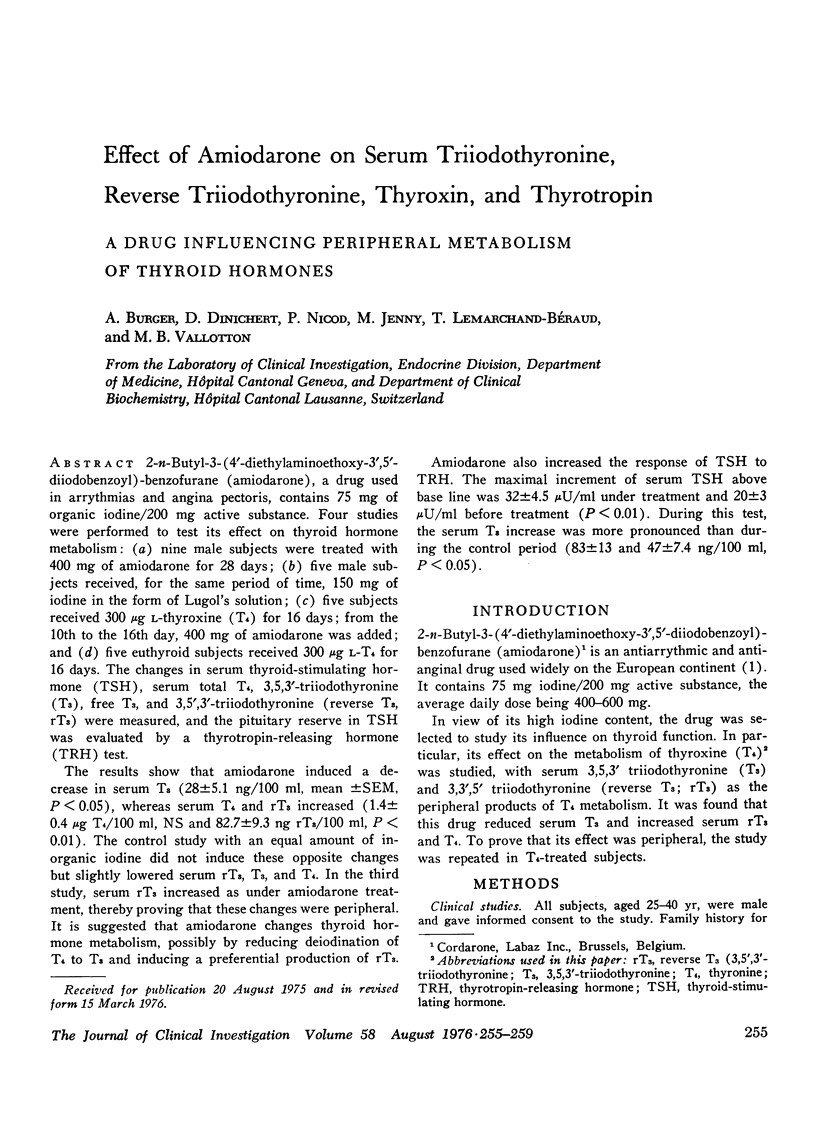
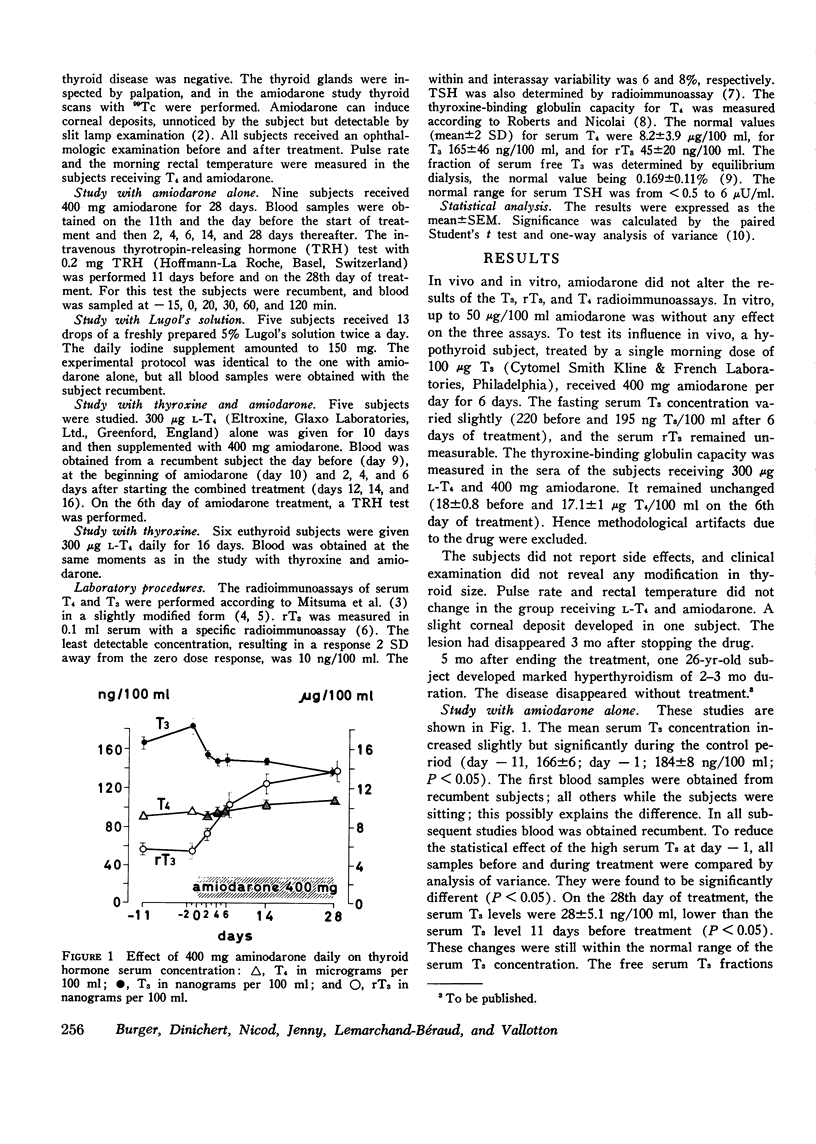
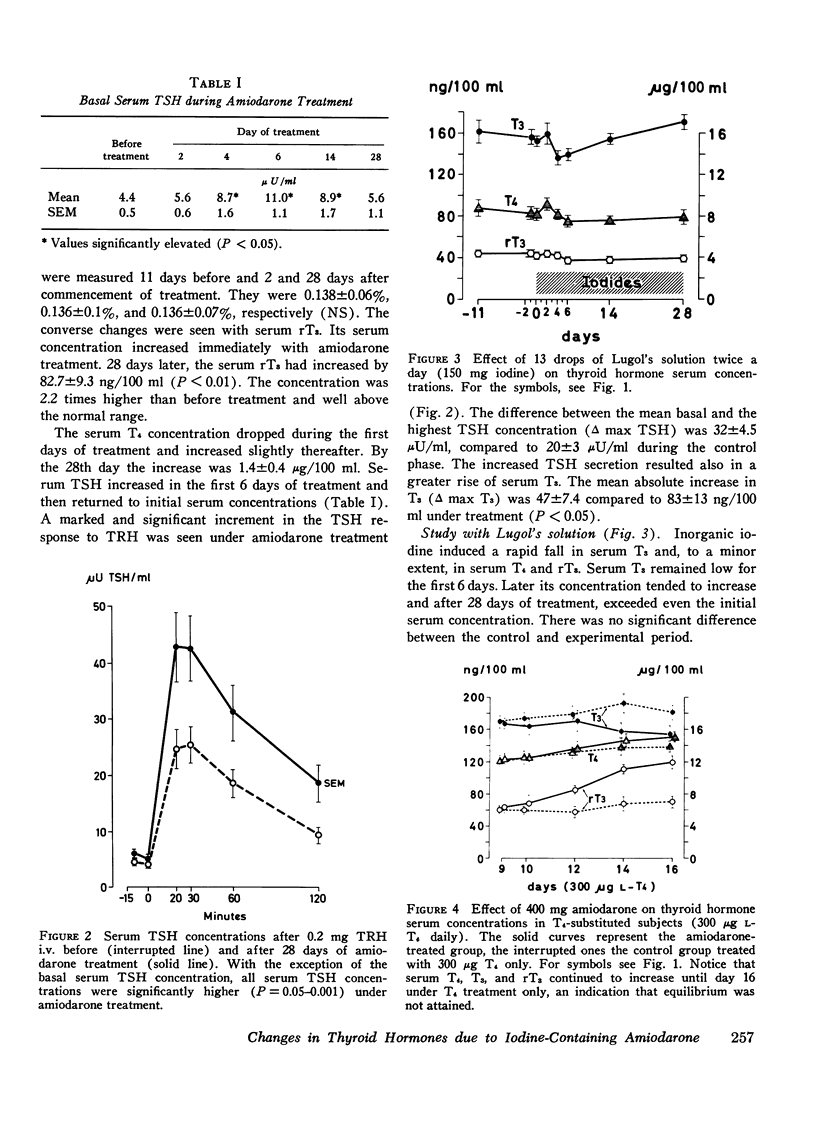
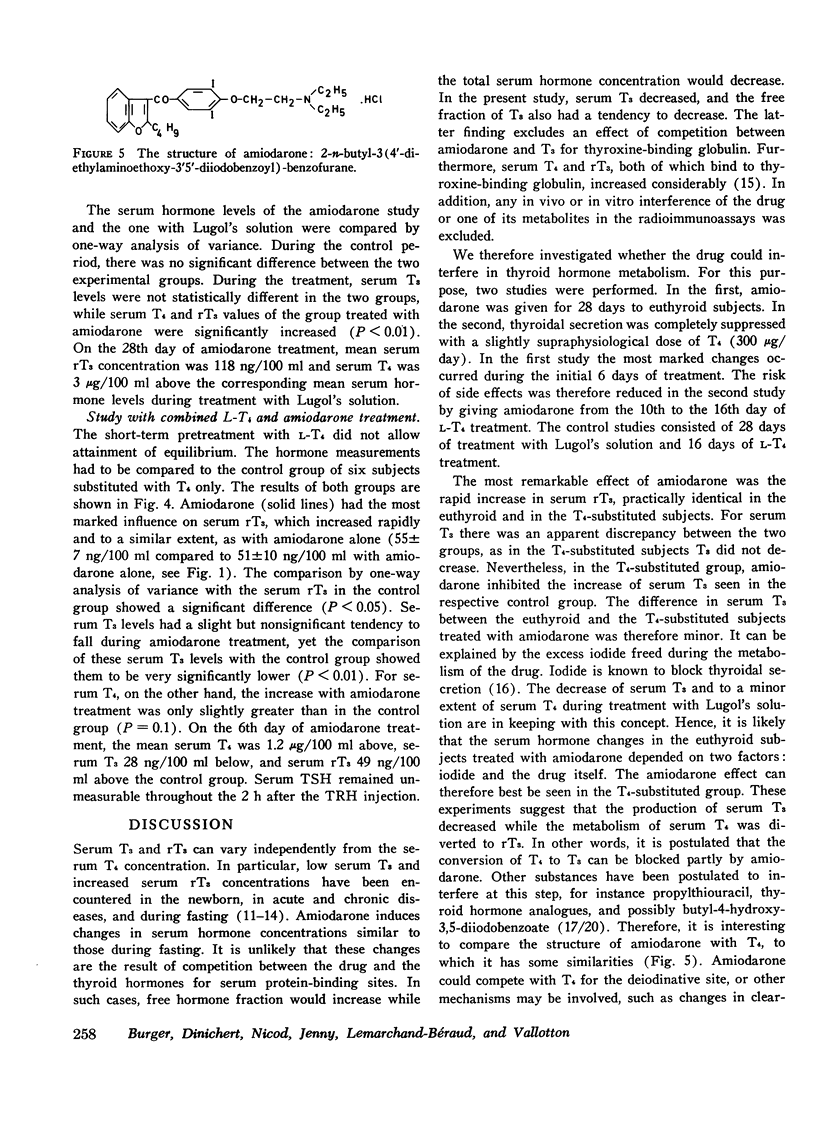
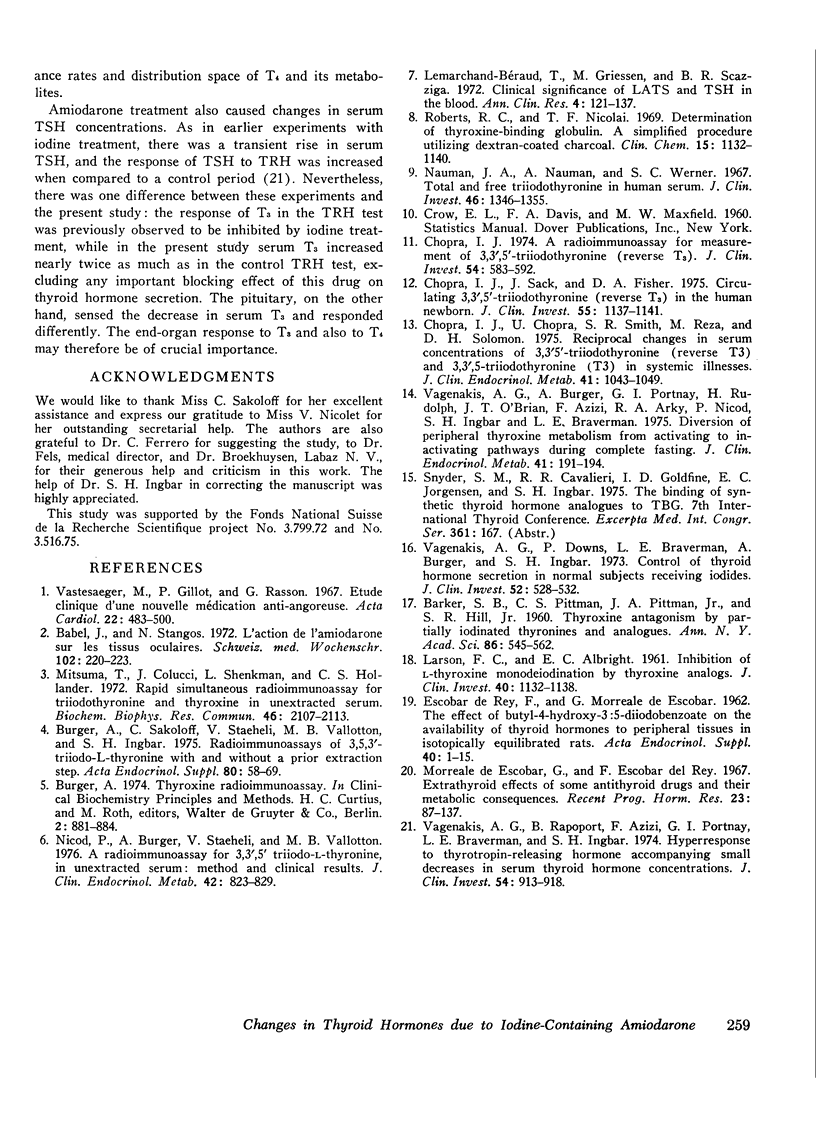
Selected References
These references are in PubMed. This may not be the complete list of references from this article.
- BARKER S. B., PITTMAN C. S., PITTMAN J. A., Jr, HILL S. R., Jr Thyroxine antagonism by partially iodinated thyronines and analogues. Ann N Y Acad Sci. 1960 Apr 23;86:545–562. doi: 10.1111/j.1749-6632.1960.tb42828.x. [DOI] [PubMed] [Google Scholar]
- Babel J., Stangos N. L'action de l'amiodarone sur les tissus oculaires. Schweiz Med Wochenschr. 1972 Feb 19;102(7):220–223. [PubMed] [Google Scholar]
- Burger A., Sakoloff C., Staeheli V., Vallotton M. B., Ingbar S. H. Radioimmunoassays of 3,5,3'-triiodo-L-thyronine with and without a prior extraction step. Acta Endocrinol (Copenh) 1975 Sep;80(1):58–69. doi: 10.1530/acta.0.0800058. [DOI] [PubMed] [Google Scholar]
- Chopra I. J. A radioimmunoassay for measurement of 3,3',5'-triiodothyronine (reverse T3). J Clin Invest. 1974 Sep;54(3):583–592. doi: 10.1172/JCI107795. [DOI] [PMC free article] [PubMed] [Google Scholar]
- Chopra I. J., Chopra U., Smith S. R., Reza M., Solomon D. H. Reciprocal changes in serum concentrations of 3,3',5-triiodothyronine (T3) in systemic illnesses. J Clin Endocrinol Metab. 1975 Dec;41(06):1043–1049. doi: 10.1210/jcem-41-6-1043. [DOI] [PubMed] [Google Scholar]
- Chopra I. J., Sack J., Fisher D. A. Circulating 3,3', 5'-triiodothyronine (reverse T3) in the human newborn. J Clin Invest. 1975 Jun;55(6):1137–1141. doi: 10.1172/JCI108030. [DOI] [PMC free article] [PubMed] [Google Scholar]
- ESCOBAR DEL REY F., MORREALE DE ESCOBAR G. The effect of butyl-4-hydroxy-3:5-diiodobenzoate on the availability of thyroid hormones to peripheral tissues in isotopically equilibrated rats. Acta Endocrinol (Copenh) 1962 May;40:1–15. doi: 10.1530/acta.0.0400001. [DOI] [PubMed] [Google Scholar]
- LARSON F. C., ALBRIGHT E. C. Inhibition of L-thyroxine monodeiodination by thyroxine analogs. J Clin Invest. 1961 Jul;40:1132–1138. doi: 10.1172/JCI104342. [DOI] [PMC free article] [PubMed] [Google Scholar]
- Lemarchand-Béraud T., Griessen M., Scazziga B. R. Clinical significance of LATS and TSH in the blood. Ann Clin Res. 1972 Jun;4(3):121–137. [PubMed] [Google Scholar]
- Mitsuma T., Colucci J., Shenkman L., Hollander C. S. Rapid simultaneous radioimmunoassay for triiodothyronine and thyroxine in unextracted serum. Biochem Biophys Res Commun. 1972 Mar 24;46(6):2107–2113. doi: 10.1016/0006-291x(72)90766-8. [DOI] [PubMed] [Google Scholar]
- Morreale de Escobar G., Escobar del Rey F. Extrathyroid effects of some antithyroid drugs and their metabolic consequences. Recent Prog Horm Res. 1967;23:87–137. doi: 10.1016/b978-1-4831-9826-2.50006-4. [DOI] [PubMed] [Google Scholar]
- Nauman J. A., Nauman A., Werner S. C. Total and free triiodothyronine in human serum. J Clin Invest. 1967 Aug;46(8):1346–1355. doi: 10.1172/JCI105627. [DOI] [PMC free article] [PubMed] [Google Scholar]
- Nicod P., Burger A., Staeheli V., Vallotton M. B. Radioimmunoassay for 3,3',5'-triiodo-L-thyronine in unextracted serum: method and clinical results. J Clin Endocrinol Metab. 1976 May;42(5):823–829. doi: 10.1210/jcem-42-5-823. [DOI] [PubMed] [Google Scholar]
- Roberts R. C., Nikolai T. F. Determination of thyroxine-binding globulin. A simplified procedure utilizing dextran-coated charcoal. Clin Chem. 1969 Dec;15(12):1132–1140. [PubMed] [Google Scholar]
- Vagenakis A. G., Burger A., Portnary G. I., Rudolph M., O'Brian J. R., Azizi F., Arky R. A., Nicod P., Ingbar S. H., Braverman L. E. Diversion of peripheral thyroxine metabolism from activating to inactivating pathways during complete fasting. J Clin Endocrinol Metab. 1975 Jul;41(1):191–194. doi: 10.1210/jcem-41-1-191. [DOI] [PubMed] [Google Scholar]
- Vagenakis A. G., Downs P., Braverman L. E., Burger A., Ingbar S. H. Control of thyroid hormone secretion in normal subjects receiving iodides. J Clin Invest. 1973 Feb;52(2):528–532. doi: 10.1172/JCI107212. [DOI] [PMC free article] [PubMed] [Google Scholar]
- Vagenakis A. G., Rapoport B., Azizi F., Portnay G. I., Braverman L. E., Ingbar S. H. Hyperresponse to thyrotropin-releasing hormone accompanying small decreases in serum thyroid hormone concentrations. J Clin Invest. 1974 Oct;54(4):913–918. doi: 10.1172/JCI107831. [DOI] [PMC free article] [PubMed] [Google Scholar]


